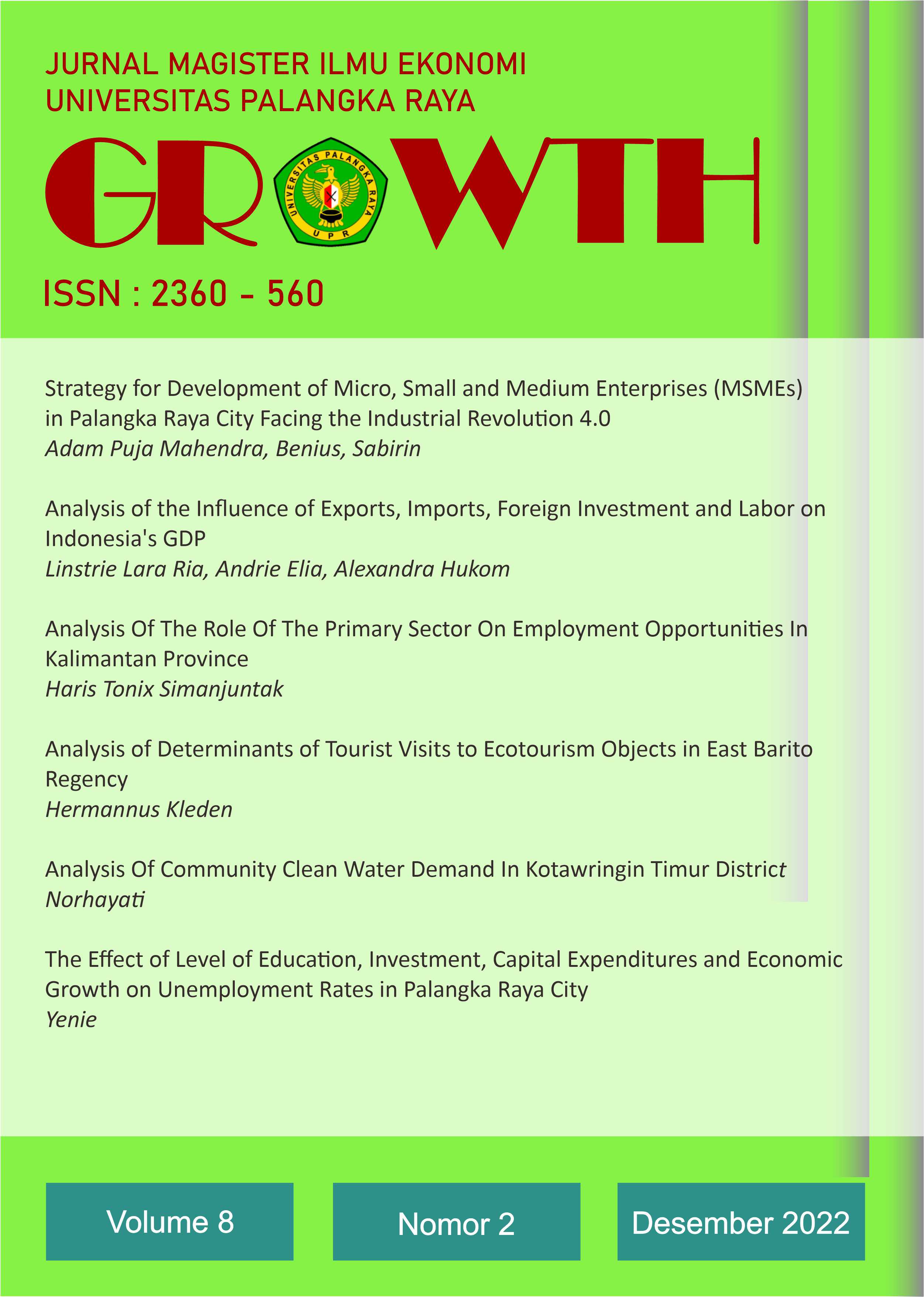Strategy for Development of Micro, Small and Medium Enterprises (MSMEs) in Palangka Raya City Facing the Industrial Revolution 4.0
DOI:
https://doi.org/10.52300/grow.v8i2.9165Keywords:
Business Development Strategy, MSME, SWOTAbstract
This study aims to determine the characteristics of MSMEs in the city of Palangka Raya and analyze the strategy of developing MSMEs in the city of Palangka Raya based on the internal and external situation of MSMEs. The sample used in this study amounted to 45 MSMEs in the city of Palangka Raya. The types of data used are primary and secondary data. This study uses descriptive analysis tools, environmental analysis (internal and external), and SWOT analysis. The results of this study indicate that the characteristics of MSMEs in Palangka Raya City are more dominant in the trading business sector with a percentage reaching 71.25%. In determining the MSMEs development strategy in Palangka Raya City, it is seen based on environmental analysis and SWOT analysis, which shows the position is in quadrant I where market penetration and product development are strategies that can be used, then the SO (Strengths-Opportunities) strategy is a strategy that uses strength to take advantage of existing opportunities, expand distribution reach and establish cooperative/partnership relationships as alternative strategies in this analysis.
Downloads
References
Ali Ibraham Hasyim. 2016. Ekonomi Makro.
Jakarta : Kencana.
Arsyad, Lincolin. 1999. Ekonomi Pembangunan: Edisi Keempat. Yogyakarta : STIE YKPN.
Bambang, Hariadi. 2005. Strategi Manajemen. Jakarta : Bayumedia Publising.
David, F.R. 2006, “Manajemen Strategis : Konsep, Edisi Sepuluh”. Jakarta : Selemba Empat.David, F.R. 2004, “Manajemen Strategis : Konsep, Edisi ketujuh”. Jakarta : PT. Prenhallindo.
Fadilah S. 2012. “Pengaruh Implementasi Pengendalian Intern dan Total Quality Manajemen Terhadap Kinerja Organisasi”. MIMBAR, Vol. XXVIII No.1.
Gie Kian, K. 2003. Perekonomian Indonesia Tahun 2004, Prospek dan Kebijakan. Kantor Menteri Negara Perencanaan Pembangunan Nasional/ Badan Perencanaan Pembangunan Nasional (Bappenas).
Hardjono, Winardi. 2000. Manajemen Pemasaran Modern dan Perilaku Konsumen. Bandung : Penerbit Sinar Baru.
Hasibuan, Melayu S.P. 2003. Manajemen Sumber Daya Manusia, Edisi Revis. Jakarta : Bumi Aksara.
HEPI, H., & ZAKIAH, W. (2018). The Influence of Life Expectancy Rate And Old School Rate To GRDP Percapita and Economic Growth In Central Kalimantan Province 2011-2015. Journal Magister Ilmu Ekonomi Universtas Palangka Raya: GROWTH, 4(1), 56-68.
Husein, Umar. 2008. Metode Penelitian untuk Skripsi dan Tesis Bisnis. Jakarta : PT RajaGrafindo Persada.
Kagerman, H.,Wahlster, W. & Helbig, J. 2003. Recommendations for Implementing the Strategic Intiative Industry 4.0 Industry 4.0 Working Group. Germany.
Laksamana, R., & Giovanni, J. (2019). Persepsi Usaha Mikro Kecil dan Menengah (UMKM) Terhadap Transportasi Online di Wilayah Kalimantan Barat. Jurnal Manajemen Motivasi, 15(2), 48-54.
Miar, M., Neneng, S., & Sui, J. M. (2022). The Impact Covid-19 Outbreak, Green Finance, Creativity and Sustainable Economic Development on the Economic Recovery in G20 Countries. International Journal of Energy Economics and Policy, 12(6), 432.
Rahmana, Arief. 2008. Usaha Kecil dan Menengah (UKM), Informasi terdepan usaha kecil menengah (online), http://infoukm.wordpress.com diakses 2 februari 2022
Schwab, Klaus. 2017. The Fourth Industrial Revolution. World Economic Forum: Germany.
Soeroto. 1986. Strategi Pembangunan dan Perencanaan Tenaga Kerja. UGM Pers. Yogyakarta.
Sugiyono. 2003. Metode Penelitian. Bandung: Alfabeta.
Sumitro. 1995. Ekonomi Pembangunan. Jakarta: Pustaka Ekonomi.
Undang-Undang Nomor 20 Tahun 2008 Tentang Usaha Mikro Kecil dan Menengah.
Undang-Undang Nomer 13 tahun 2003 pasal 1 tentang Ketenagakerjaan





